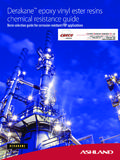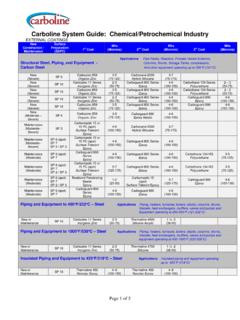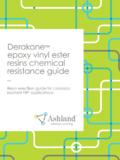Transcription of 15 reactors series parallel - utkstair.org
1 1 Lecture 15: reactors in series and parallel David J. Keffer Department of chemical and Biomolecular Engineering The University of Tennessee, Knoxville begun: September 25, 2009 last updated: September 26, 2011 I. parallel Identical reactors in parallel behave just like a single reactor. Only the through-put is multiplied by the number of reactors . This is true for BRs, CSTRs and PFRs. II. series CSTRs in series Example. Consider a set of identical CSTRs in series . If we have one reactor with a volume of 10 liters, with the parameters given by the following input file function dydt = sysodeinput(x,y,nvec); % % one reaction % 2A --> B % % example usage: % [y,x] = sysode(2,1000,0,100,[0,0]); % CA = y(1); CB = y(2); nuA = ; nuB = ; % constant volume; F = 1; % liter/sec Fin = F; Fout = F; CAin = ; % mol/liter CBin = ; % mol/liter V = 10; % liter R = ; % J/mol/K T = 300; % K ko = ; % liter/mol/sec Ea = 2500; % J/mol k = ko*exp(-Ea/(R*T)); rate = k*CA*CA; 2 % % molar balances % dydt(1) = Fin/V*CAin - Fout/V*CA + nuA*rate; dydt(2) = Fin/V*CBin - Fout/V*CB + nuB*rate.
2 We can type at the command line prompt [y,x] = sysode(2,1000,0,200,[0,0]); and obtain the following output: The final concentration of A is moles/liter. If we have two reactors in series each with a volume of 5 liters, with all other parameters remaining unchanged and given by the input file function dydt = sysodeinput(x,y,nvec); % % CSTR in series % one reaction % 2A --> B % % example usage: 3 % [y,x] = sysode(2,1000,0,100,[0,0,0,0]); % CA1 = y(1); CB1 = y(2); CA2 = y(3); CB2 = y(4); nuA = ; nuB = ; % constant volume; F = 1; % liter/sec Fin1 = F; Fout1 = F; Fin2 = F; Fout2 = F; CAin1 = ; % mol/liter CBin1 = ; % mol/liter CAin2 = CA1; % mol/liter CBin2 = CB1; % mol/liter V1 = 5; % liter V2 = 5; % liter R = ; % J/mol/K T = 300; % K ko = ; % liter/mol/sec Ea = 2500; % J/mol k = ko*exp(-Ea/(R*T)).
3 Rate1 = k*CA1*CA1; rate2 = k*CA2*CA2; % % molar balance on reactor 1 % dydt(1) = Fin1/V1*CAin1 - Fout1/V1*CA1 + nuA*rate1; dydt(2) = Fin1/V1*CBin1 - Fout1/V1*CB1 + nuB*rate1; % molar balance on reactor 2 dydt(3) = Fin2/V2*CAin2 - Fout2/V2*CA2 + nuA*rate2; dydt(4) = Fin2/V2*CBin2 - Fout2/V2*CB2 + nuB*rate2; We can type at the command line prompt [y,x] = sysode(2,1000,0,200,[0,0,0,0]); and obtain the following output: 4 The final concentration of A is moles/liter. If we have five reactors in series each with a volume of 2 liters, with all other parameters remaining unchanged and given by the input file (Here we have generalized the input file to work for an arbitrary number of reactors , by simply changing the variable nr.)
4 Function dydt = sysodeinput(x,y,nvec); % % CSTR in series % one reaction % 2A --> B % % example usage: % [y,x] = sysode(2,1000,0,100,[0,0,0,0,0,0,0,0,0,0 ]); % % number of reactors = nr nr = 5; for i = 1:1:nr CA(i) = y(2*i-1); CB(i) = y(2*i); end % nuA = ; nuB = ; % constant volume; F = 1; % liter/sec for i = 1:1:nr 5 Fin(i) = F; Fout(i) = F; end CAin(1) = ; % mol/liter CBin(1) = ; % mol/liter for i = 2:1:nr CAin(i) = CA(i-1); CBin(i) = CB(i-1); end Vtot = 10; % liter for i = 1:1:nr V(i) = Vtot/nr; end % R = ; % J/mol/K T = 300; % K ko = ; % liter/mol/sec Ea = 2500; % J/mol k = ko*exp(-Ea/(R*T)); for i = 1:1:nr rate(i) = k*CA(i)*CA(i); end % % molar balance on reactor 1 % for i = 1:1:nr dydt(2*i-1) = Fin(i)/V(i)*CAin(i) - Fout(i)/V(i)*CA(i) + nuA*rate(i); dydt(2*i) = Fin(i)/V(i)*CBin(i) - Fout(i)/V(i)*CB(i) + nuB*rate(i); end We can type at the command line prompt yo = zeros(1,10); [y,x] = sysode(2,1000,0,200,yo) ; and obtain the following output: 6 0204060801001201401601802000123456xy The final concentration of A is moles/liter.
5 If we have 10, 20, or 100 reactors in series each with a volume of respectively 1, or liters, with all other parameters remaining unchanged and given by the same input file used in the 5 reactor example above with the single change that nr now is set equal to 10, 20, or 100, then we can type at the command line prompt, respectively yo = zeros(1,20); [y,x] = sysode(2,1000,0,200,yo) ; yo = zeros(1,40); [y,x] = sysode(2,1000,0,200,yo) ; yo = zeros(1,200); [y,x] = sysode(2,1000,0,100,yo) ; and obtain the following outputs: 7 02040608010012014016018020001234567xy output for 10 reactors 020406080100120140160180200012345678xy 8 Output for 20 reactors 0102030405060708090100012345678910xy output for 100 reactors The final concentration of A in 5 reactors is moles/liter.
6 The final concentration of A in 10 reactors is moles/liter. The final concentration of A in 20 reactors is moles/liter. If we have a PFR with the same total volume as the CSTRs above (for example a diameter of m and a length of m) above all other parameters equal, as in the following input file, function dydt = sysodeinput(x,y,nvec); % % one reaction % 2A --> B % % sample command % [y,x] = sysode(2,1000,0, ,[10000,0]); % CA = y(1); CB = y(2); % % define the stoichiometry % nuA = ; nuB = ; 9 % % define the rate law % R = ; % J/mol/K T = 300; % K ko = ; % liter/mol/sec ko = ko/1000; % m^3/mol/sec Ea = 2500; % J/mol k = ko*exp(-Ea/(R*T)); rate = k*CA*CA; % % define mole balance % % volumetric flowrate F = 1; % liter/sec F = F/1000.
7 % cubic meters/sec % % circular pipe % Vtot = ; % liters Vtot = Vtot/1000; % cubic meters Dp = ; % m Across = *pi*Dp*Dp; % m^2 l = Vtot/Across; % m % % velocity % v = F/Across; % m/s % % residence time % tr = l/v; % sec % % molar balances % % dCAdz = nuA*r/v dydt(1) = (nuA*rate)/v; dydt(2) = (nuB*rate)/v; We use the following command [y,x] = sysode(2,1000,0, ,[10000,0]); to obtain the following output 10 The final concentration of A in the PFR is mol/liter. We summarize the results in the following table: reactor type number of reactors final concentration of A (moles/liter) CSTR 1 CSTR 2 CSTR 5 CSTR 10 CSTR 20 CSTR 100 PFR 1 The conclusion from this set of examples is that, if the total volume is kept the same, as the number of CSTRs approaches infinity, the conversion approaches that of the PFR.
8 11 PFRs in series PFRs in series behave as if 1 PFR of equal volume. In the example above, we have one PFR of diameter m and length m. In this example, we will have two PFRs of diameter and each half as long. The input file is unchanged. The length is halved in the command prompt is [y,x] = sysode(2,1000,0, ,[10000,0]); The output looks like The output concentrations from A and B from the first PFR is +003 +003 moles/m3. We use this output in the second reactor with the same input file and initial conditions that correspond to the output of the first reactor [y,x] = sysode(2,1000,0, ,[ , ]); 12 The final concentrations of A and B are 1199 and 4400 moles/m3.
9 , which is the same concentration as obtained for the single PFR in the example above. BRs in series BRs of equal volume in series behave as a single BR of the same volume in which the reaction is allowed to take place for the sum of the residence times of the reactors in series . In essence, this is a pointless task. You are moving the contents from one pot to another pot and allowing the same reaction to continue in a new location. Of course, if there is some other physics going on, like fouling of a catalyst, moving the material to a new pot with fresh catalyst is of course not pointless. 13 Lecture 16: Combinations of reactors David J. Keffer Department of chemical and Biomolecular Engineering The University of Tennessee, Knoxville last updated: September 28, 2009 Graphical Analysis of reactors in series Look at graphs 2-6 page 58 2-8 page 59 2-11 page page 62 page 65 Example of reactors in series Consider an elementary, irreversible isomerization reaction of A to B in a PFR followed by a CSTR, both operated at steady state.
10 Also consider placing the CSTR first. Compare the two results. This is an isomerization reaction of A to B. A B The stoichiometric coefficients are 1 A and 1 B This is an elementary reaction. Therefore the rate is of the form AkCr The mole balance for the PFR is rdVdCFAA Substitute rate law and stoichiometry into the mole balance. AACFkdVdC This ODE can be solved by hand. 14 PFRAoAVCCAAdVFkCdC0, PFRoAAVFkCC ,ln PFRoAAVFkCCexp, This is the outlet concentration of the PFR. This is also the inlet concentration to the CSTR. The steady-state CSTR mole balance is rCVFCVFAACSTRinACSTR .0 Substitute rate law and stoichiometry into the mole balance.








